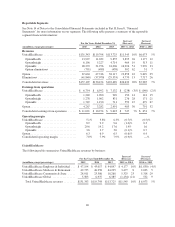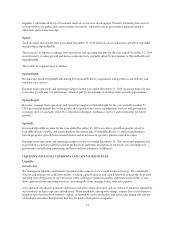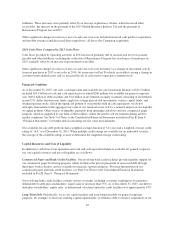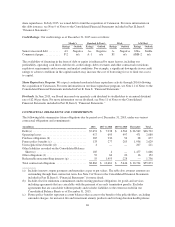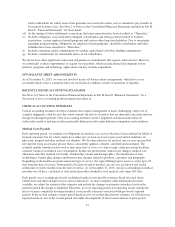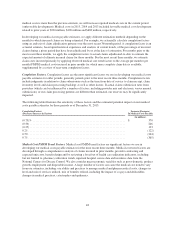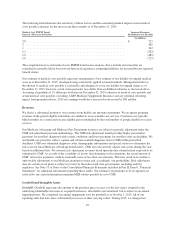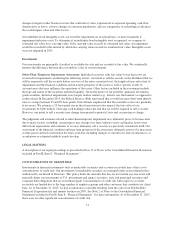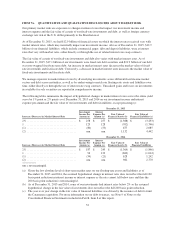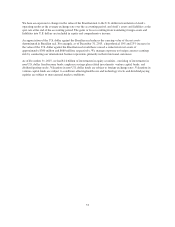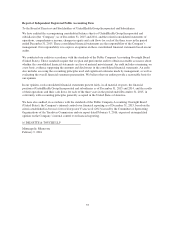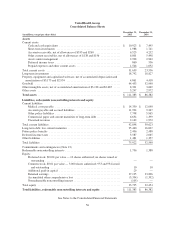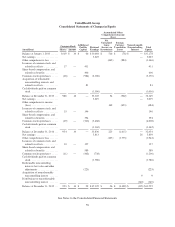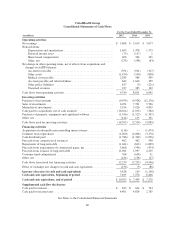United Healthcare 2015 Annual Report Download - page 52
Download and view the complete annual report
Please find page 52 of the 2015 United Healthcare annual report below. You can navigate through the pages in the report by either clicking on the pages listed below, or by using the keyword search tool below to find specific information within the annual report.annual quantitative goodwill impairment testing date from January 1 to October 1 of each year. The change in the
goodwill impairment test date better aligns the impairment testing procedures with the timing of our long-term
planning process, which is a significant input to the testing. This change in testing date did not delay, accelerate,
or avoid a goodwill impairment charge. Impairment tests are performed more frequently if events occur or
circumstances change that would more likely than not reduce the fair value of the reporting unit below its
carrying amount.
To determine whether goodwill is impaired, we perform a multi-step test measuring the fair values of the
reporting units and comparing them to their aggregate carrying values, including goodwill. If the fair value is less
than the carrying value of the reporting unit, then the implied value of goodwill would be calculated and
compared to the carrying amount of goodwill to determine whether goodwill is impaired.
We estimate the fair values of our reporting units using discounted cash flows, which include assumptions about
a wide variety of internal and external factors. Significant assumptions used in the impairment analysis include
financial projections of free cash flow (including significant assumptions about operations, capital requirements
and income taxes), long-term growth rates for determining terminal value beyond the discretely forecasted
periods and discount rates. For each reporting unit, comparative market multiples are used to corroborate the
results of our discounted cash flow test.
Forecasts and long-term growth rates used for our reporting units are consistent with, and use inputs from, our
internal long-term business plan and strategies. Key assumptions used in these forecasts include:
•Revenue trends. Key revenue drivers for each reporting unit are determined and assessed. Significant factors
include: membership growth, medical trends and the impact and expectations of regulatory environments.
Additional macro-economic assumptions relating to unemployment, GDP growth, interest rates and
inflation are also evaluated and incorporated, as appropriate.
•Medical cost trends. For further discussion of medical cost trends, see the “Medical Cost Trend” section of
Executive Overview-Business Trends above and the discussion in the “Medical Costs Payable” critical
accounting estimate above. Similar factors, including historical and expected medical cost trend levels, are
considered in estimating our long-term medical trends at the reporting unit level.
•Operating productivity. We forecast expected operating cost levels based on historical levels and
expectations of future operating cost levels.
•Capital levels. The operating and long-term capital requirements for each business are considered.
Discount rates are determined for each reporting unit and include consideration of the implied risk inherent in
their forecasts. Our most significant estimate in the discount rate determinations involves our adjustments to the
peer company weighted average costs of capital that reflect reporting unit-specific factors. We have not made
any adjustments to decrease a discount rate below the calculated peer company weighted average cost of capital
for any reporting unit. Company-specific adjustments to discount rates are subjective and thus are difficult to
measure with certainty.
The passage of time and the availability of additional information regarding areas of uncertainty with respect to
the reporting units’ operations could cause these assumptions to change in the future.
Intangible Assets. Our recorded separately-identifiable intangible assets were acquired in business combinations
and were initially recorded at their fair values. Finite-lived intangible assets are amortized over their expected
useful lives, while indefinite-lived intangible assets are evaluated for impairment on at least an annual basis.
Our finite-lived intangible assets are subject to impairment tests when events or circumstances indicate that an
asset’s (or asset group’s) carrying value may exceed its estimated fair value. Consideration is given on a
quarterly basis to a number of potential impairment indicators, including: changes in the use of the assets,
50


